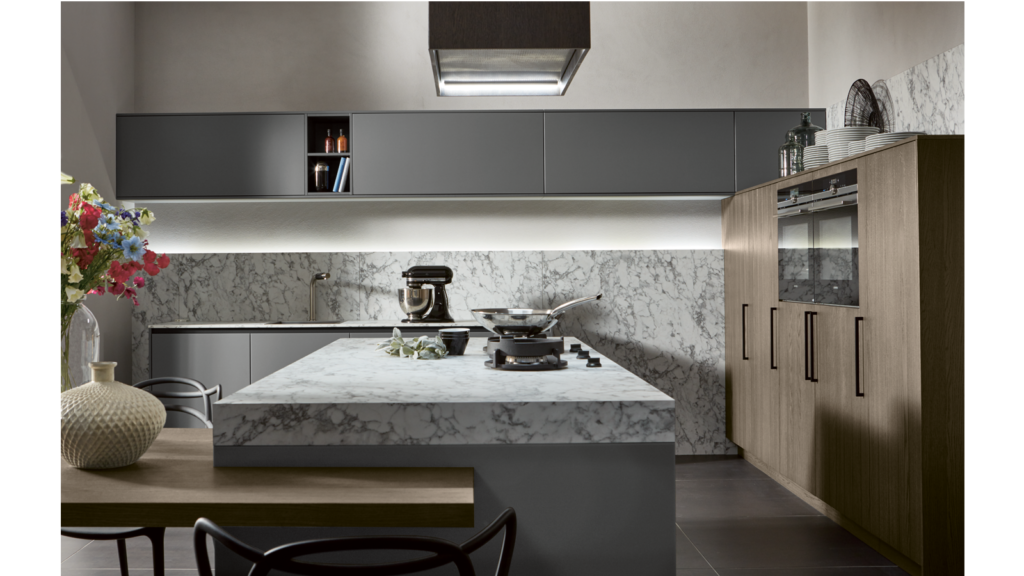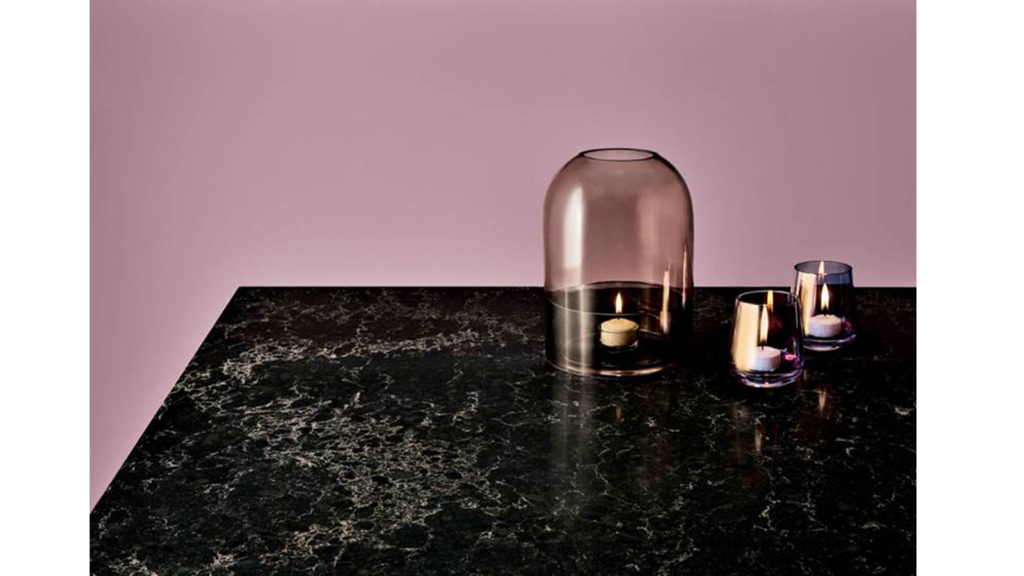We take a look at how natural stone-effect worktops have made an impact broadening sales and design potential.
Bringing the outdoors into the home is nothing new, with natural materials forming an intrinsic part of high-end interior design.

Part of the Ceralsio ceramic surfacing collection from CRL Stone is Cervino, which features marble-inspired patterning on a white background. It is available in a satin finish.
Marble, granite and concrete have been the go-to for kitchen worktops, however a raft of stone-effects spanning quartz, porcelain, solid surface and laminate have made the trend more accessible.
Sponsored Video
This doesn’t only mean it is within reach of a broader span of budgets, although undoubtedly stone-effects are far less price prohibitive, but also offer greater design possibilities.
As part of the hypernature trend, the inherent material qualities of stone effects may actually be better than natural stone – think ease of fitting, reduction of weight, seamless joints and an impermeable structure.
Broader design possibilities

As part of a four-strong luxury laminate worktop launch, Pronorm has introduced the Marble Carrara. It can be used for worktops, splashbacks, panels and cladding.
Managing director of Daval Simon Bodsworth comments: “We have found that stone-effect surfaces have opened up a myriad of design possibilities, especially with the current trend for mixed materials, encouraging end users to explore new techniques, finishes and solutions.”
In fact, Pronorm recently introduced stone effect laminates worktops in a choice of thicknesses from 16mm through to 100mm “to contrast thinner and thicker worksurfaces together as a style element in a scheme”, explains UK & Ireland business manager Jason Grinton.
And head of UK operations of Rotpunkt Matt Phillips says using stone-effect worktops allow designer to meet the trend for larger surfaces, explaining: “It’s possible to achieve a large expanse of marble – worktop, splashback and wall panelling – without the risk of cracking, due to the product being lightweight, cost-effective and sustainable.”
In fact, this is reflected in the HQ showroom of Pronorm, as Jason Grinton comments: “We created a monolithic island unit completely clad in stone effect laminate that looks outstanding, which in other materials would be eye-wateringly expensive, as well as challenging to fabricate, handle and install”
He adds: “Several of our retailers have replicated this exact set in their showroom to show its design potential and it has worked very well for them.”
Country and contemporary
The beauty of stone-effect worktops is that they can meet the trends for country styled classical kitchens as well as more urban looks.

Corian has extended its palette with the introduction of Aggregate, Terrazo, Nuwood and additions to Onyx and Prima, available through CD UK. Adding to its Prima range is Smoke Drift (shown) with wisps of chocolate and caramel
Managing director of CRL Stone Simon Boocock elaborates. “The shift towards industrial styling in the kitchen has helped with stone-effect surfaces now being chosen for the contemporary setting too, rather than just being seen as appropriate for a more classically-styled setting.”
And head of operations at Brandt Kitchens Julia Steadman agrees, adding: “A chunky stone-effect worktop fuses beautifully with classic Shaker-style cabinets for an update on a country kitchen whilst a stone-effect worktop, with a thinner profile, is the perfect partner for a modern kitchen.”
And, of course, stone-effects tie in with the ongoing trend for grey tones in the home, too.
But the question hot on every kitchen designer’s lips must be what stone-effects should they have in their arsenal to meet the broad consumer tastes for stone-effect worktops?
Mirroring marble
The consumer’s love affair with the white kitchen is far from, as product manager for solid surface at IDS Steven Fisher explains: “It’s worth remembering that white remains a highly popular choice in solid surface because it offers a pure aesthetic that will work in a range of kitchen schemes, as well as being timeless.”

Quartzite Blanco Nuvola by Eggersmann has a marble-like grey vein running thoughout the surface. It can be used for worktops, island units and splashbacks.
And such is the impact of white, IDS which exclusively sells solid surface Durasein reportedly holds the largest choice of whites of any distributor in the country.”
And this has influenced and helped establish the trend for marble-effects.
“This time, last year, we were seeing more in the way of marble-inspired patterns being introduced in worktops and with neutral tones continuing to dominate décor trends, the design interest that marble veining brings continues to be a great way of expressing character in the kitchen”, explains Simon Boocock of CRL Stone.
And, indeed, the veined marble continues to be popular and has just been introduced by Sylmar Technology in what it claims to be a first for solid surface – Calcutta White.

The signature décor of the Minerva range of solid surface worktops by Sylmar Technology is Calcutta White which features veining and is claimed to be an industry first.
Managing director of Sylmar Technology Peter Holt explains: “We saw the trend shift towards striking veining flowing throughout the surface, the desire for materials to be influenced by the natural world, the lure of marble and paler tones to complement decors within the modern home and we had a vision to create this as a solid surface.
“We are proud to announce what I believe to be an industry first, we have successfully created a Calcutta marble design in a solid surface worktop.
“To meet the demand of larger island sizes, we are also able to create larger pieces than before.”
The company also recently introduced three concrete-inspired decors to its Minerva range – Travertine Haze, Silver Haze and Concrete Haze.
Peter Holt commented: “Throughout the world there is a trend for lighting surfaces, colours to complement grey tones, natural materials and a semi-industrial look for the kitchen.”
While Karonia, which manufactures Mistral solid surface worktops, opts to not mimic but be influenced by natural stone instead.
Director of Karonia Andrew Pick-up explains: “We also inform the process with current trends. This way we begin with a classic idea and combine it with our market knowledge and experiences.”
It has recently introduced Aria, based on its sparkling white Polaris décor, which features marble-inspired veins.

Moonscape has recently been added to the Mistral solid surface worktop collection by Karonia. It features a mix of concrete grey and sparking while with random swirls so each piece is unique.
Dark and dramatic
But what’s next for stone-effect worktops? While Calacatta marble-styles remain perennially popular, the paler shades have been joined by more dramatic veining.

Reflecting the trend for dark, natural stone decors is the quartz worktop 5100 Vanilla Noir, from Caesarstone. Part of the Supernatural Design Collection it features a veined surface.
Jason Grinton of Pronorm explains: “The trend started with paler neutrals and whites, moved into the still very popular Calacatta marble territory and latterly into more dramatic colours and richer veining.”
And marketing co-ordinator for Cosentino UK & Ireland Laura Davie agrees: “Previously, surface trends have been driven by demand for classic marble-look surfaces – so those with creamy white and grey veining inspired by natural stones such as Calacatta Marble.
“Now, more so, the emphasis is on a realistic look and the neutral hues in our homes are moving away from colder palettes, so softer tones such as our Dekton Arga, inspired by Taj Mahal quartzite and Dekton Korso, with its warm grey colouring are growing in popularity.”
While Caesarstone believes that darker colours will also beco
me a key focus for the on-trend kitchen studio, as Jon Stanley, vice president of marketing for Caesarstone UK says: “There is a recent movement in bespoke interiors that is seeing designers and consumers step away from the traditional white kitchen worktop in favour of a darker, more dramatic look that incorporates tactile textures and industrial elements.”
Now, more than ever, there is a variety of decors across a variety of surfacing materials, to meet the demand for stone-effect surfacing, at every budget. So there’s no excuse not to rock and roll in surfacing sales.



